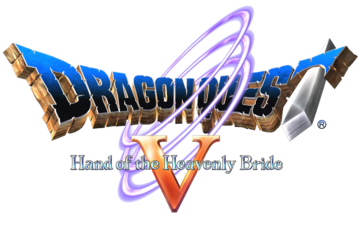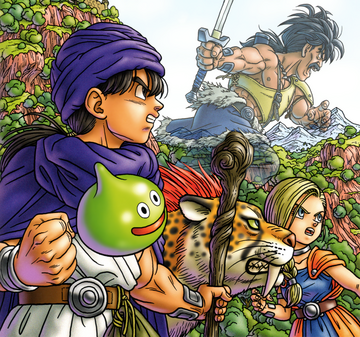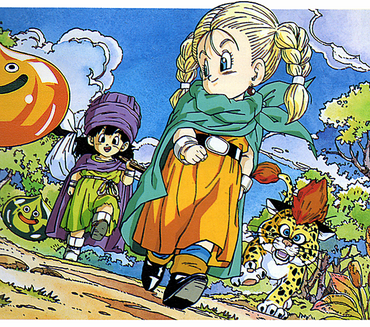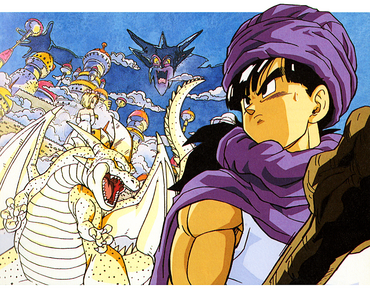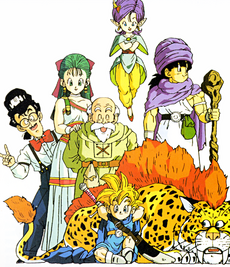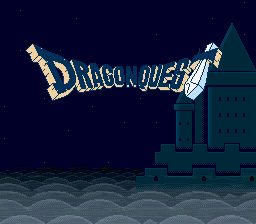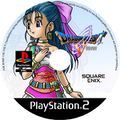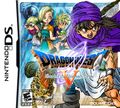Dragon Quest V: Hand of the Heavenly Bride
| Main series games | |
|---|---|
| Hand of the Heavenly Bride | |
| Developer(s) | Chunsoft ArtePiazza, Matrix Software (PS2) ArtePiazza, Cattle Call (NDS) |
| Publisher(s) | Enix Corporation (SFC) Square Enix (PS2, DS) |
| Designer(s) | Yuji Horii |
| Artist(s) | Akira Toriyama |
| Composer(s) | Kōichi Sugiyama |
| Series | Dragon Quest |
| Platform(s) | Super Famicom, PlayStation 2, Nintendo DS, Cell phone |
| Release date(s) | Super Famicom JP September 27, 1992 PlayStation 2 JP March 25, 2004 Nintendo DS JP July 17, 2008 NA February 17, 2009 EU February 20, 2009 AUS February 19 2009 Cell phone JP December 12, 2014 NA January 22, 2015 |
| Genre(s) | Console role-playing game |
| Mode(s) | Single player |
| Rating(s) | CERO: A (PS2, NDS) ESRB: E10+ (NDS) PEGI: 12+ (NDS) |
| Media | 16-megabit cartridge (SFC) DVD (PS2) Nintendo DS Game Card |
Dragon Quest V (ドラゴンクエストV 天空の花嫁 Doragon Kuesuto Faibu: Tenkū no Hanayome, lit. Dragon Quest V: Bride of Heaven) is the fifth installment in the Dragon Quest series, and the second of the Zenithian trilogy.
Dragon Quest V was the first game in the series in which certain monsters from random encounters may offer to join the player's party. This concept was an inspiration for the Pokémon video game series, which debuted several years after Dragon Quest V's release. Later, the same feature would spawn the Dragon Quest Monsters series in 1998.
On April 3rd, 2019 a trailer was released for Your Story, a feature film based on Dragon Quest V. It released later that year in Japan on August 2nd, 2019.
Setting[edit]
Dragon Quest V is set centuries after The Zenithian Hero defeated Psaro the Manslayer in the previous installment. The game starts on a sea vessel, with The Hero and his father departing to go to Whealbrook.
The layout of the world is superficially similar to the layout in Dragon Quest IV, but with a new set of locations, and considerable geographic alteration. The Stairway to Zenithia and Zenithia Castle itself are the only surviving locations from the previous game, and they have fallen into ruin and are no longer connected. The overworld has different monster encounter tables for each of the three eras.
The quest takes The Hero and his party to many exotic locations, such as a fairy village, a mansion made of ice, several caves, and even the depths of a volcano. The party eventually makes its way to the castle Zenithia, the hallmark of each game of the Zenithia trilogy. Like a few other Dragon Quest games, the final enemies reside in a dark world, separate from the main map.
Plot[edit]
Dragon Quest V begins with a brief scene of The Hero's birth in which the player gives The Hero a name. After that scene, The Hero finds himself in a room on board a ship with his father, Pankraz. After the ship stops at Littlehaven (ビスタ Bisuta), they leave the ship for Whealbrook, where Pankraz's friend Sancho lives. Upon arrival, The Hero meets Bianca Whitaker. After exploring the cave behind Whealbrook, he and Pankraz accompany Bianca to her town Roundbeck. Upon arrival at that town, Bianca and The Hero explore the haunted castle Uptaten Towers (レヌール Renūru), where they obtain a mysterious Gold Orb. Afterwards Pankraz and The Hero return to Whealbrook, along with a pet tiger named Saber (ボロンゴ Borongo), a monster that was saved from bullying by The Hero and Bianca.
The next day, The Hero notices a man in the town who looks very similar to him. That man asks The Hero to show him the Gold Orb and, after returning it, asks him to take care of his father Pankraz. Elsewhere in town, he finds the spirit of Honey, who asks him to return with her to her country, the snow-covered land of Faerie Lea. Upon arriving there, the two defeat the Winter Queen to allow Spring to return to the land. After accomplishing this feat, The Hero, Pankraz, and Saber travel to the eastern kingdom of Coburg (ラインハット Rainhatto), where the Hero befriends Prince Harry (ヘンリー Henrī). However, Harry is kidnapped, forcing The Hero and Pankraz to rescue him. Once The Hero finds Harry in a nearby hideout, they are attacked by a duo of powerful monsters, in which Pankraz defeats, but then a third entity appears and threatens The Hero's life, forcing Pankraz to give in. In the process, Pankraz is killed by powerful monsters, the Gold Orb is destroyed, and The Hero and Harry are sold into slavery.
The story continues ten years later, and the player finds that The Hero and Harry have grown up working on a giant temple. They get into a scuffle with the guards after seeing a girl named Maria (マリア Maria) being whipped; the three of them are released from the temple and sent drifting to the Casino town of Fortuna (オラクルベリー Orakuruberī) by Maria's brother. Here The Hero and Harry discover that Whealbrook has been destroyed by the armies of the Queen Dowager of Coburg, who has been acting as regent for Harry's half-brother Wilbur. Upon paying a visit to his homeland, Harry discovers that his stepmother has been replaced by a monster. After unmasking the fake queen using Ra's Mirror and defeating the monster, Harry and Maria marry and become an advisor to the king.
Afterwards, The Hero travels to the western continent, where he meets up with Saber once more, and travels to the town of Mostroferrato, where the wealthy nobleman Mr. Briscoletti and his daughters Nera and Debora live. He sends The Hero on a quest to retrieve two magic rings of fire and water as a test of his worthiness as a suitor for Nera. The Hero is able to accomplish this task only with the aid of Bianca, who he meets in a nearby village. Afterwards, Mr. Briscoletti offers The Hero the chance to marry Nera, but it is also possible for him to marry Bianca or, more surprisingly, Debora instead.
After the marriage, The Hero takes his bride through a great mountain path that leads to his homeland of Gotha. Upon their arrival, Sancho is shocked to see the Hero and his wife, and immediately takes them to see the current King of Gotha--Albert, the younger brother of Pankraz. The Hero must undergo a Riteof Passage before he can assume the throne, while his wife, now revealed to be pregnant, rests. During the coronation celebration, The Hero's wife is kidnapped, but the newly-born twins are safely hidden.
The Hero rushes to save his wife, but upon defeating the powerful monsters who kidnapped her, both The Hero and his wife are cursed and turned into stone; they remain this way for eight long years.
The Hero is found by his two children, now grown, and Sancho in the garden of a wealthy man's estate and is revived and taken back to Gotha castle. They still have not found the wife, but they have a lead on the whereabouts of The Hero's mother: she was from the town of Lofty Peak on the continent north of Gotha. The Hero goes there, finds more information, and procures a magic carpet and Magic Key. Travelling the world to collect the legendary "Heavenly" or "Celestial" armaments for The Legendary Hero, it is discovered that the The Hero's son, Parry is indeed The Legendary Hero sought by Pankraz almost twenty years ago.
During this stage of the journey, The Hero avenges Pankraz by killing Slon the Rook and restores the Zenith Dragon, as well as his flying castle, to their proper homes in the sky. To accomplish this, The Hero has to enter a time warp to retrieve the Gold Orb from his child self. The Hero, older and wiser, attempts to talk Pankraz out of going to Coburg to his demise, but he does not heed the warning.
After returning to the temple The Hero helped build as a slave, the Zenithian armour is found, as well as the statue of his wife. He then must go defeat King Korol in order to remove the curse from his wife, and retrieving the Circle of Life in the process. After the final source of evil is eradicated from the world, the party is told that Madalena remains in Nadiria, trying to contain the Grandmaster of the Underworld, Nimzo (ミルドラース Mirudorāsu). The Hero, his wife, and their children decide to enter the underworld to find Madalena, so together they travel there via the Nadiria Teleportal from the Estuary Sanctuary.
After passing a town of monsters that are transforming into humans, they head to the northern section of Nadiria and reach Mt. Zugzwang. Madalena is found inside, only to be killed off by Nimzo before she can seal his power. The party continues on to confront and destroy Grandmaster Nimzo, ending the threat once and for all. They return to Gotha, and have a joyful party. As the family celebrates, Pankraz and Madalena watch their son and his family from the heavens, happy and content with their progeny.
After beating the game, players can gain access to the bonus dungeon: Estark's Labyrinth, where the party can test their skills against an ancient demon sealed away by Nimzo out of fear. Dragon Quest V was the first main series Dragon Quest game to have a bonus dungeon (although the later remakes of Dragon Quest III and IV added bonus dungeons similar to later titles).
Characters[edit]
- The Hero is, in the early chapters of the game, a six-year-old boy who travels all around the world along with his father, Pankraz. Though a child, he will become a capable warrior in his own right through exorcizing a haunted castle and saving the realm of the faeries from perpetual winter. After the tragic death of Pankraz at the end of the first generation, The Hero is forced into slavery, undergoing hard labor in the building of a temple. Ten years after, he finally escapes from there, and he starts a journey to find his mother, Madalena, who was rumoured to have been kidnapped soon after The Hero was born. He will also search for The Legendary Hero that his father sought to find, and along the way discover love in the form of a Heavenly Bride.
- Pankraz is the father of The Hero. Though he was once the king of Gotha, he left his homeland to search for The Legendary Hero and his vanished wife. His attendant, Sancho, goes with him on his journey and resides in Whealbrook early in the game. He is a stern but kind man, with nearly all associated NPCs speaking very highly of him. In his travels, he keeps his kingly status a secret to avoid detection.
- Bianca Whitaker is a daughter of the innkeepers of Roundbeck and the childhood friend of The Hero. When The Hero and his father visit her in Roundbeck, she drags him off on a ghost-hunting dare to save a bullied Saber cub from its aggressive owners. After growing up, she moves to a small village for recuperation of her injured father and matures into a kind and energetic countrywoman, becoming one of the women whom the player can choose to marry.
- Nera Briscoletti is a daughter of Rodrigo Briscoletti, who recently got back from domestic goddess training at Heaven's Above Abbey. She is the second choice for becoming The Hero's bride. Her father, Rodrigo Briscoletti (ルドマン Rudoman) is a wealthy man living in Mostroferrato (サラボナ Sarabona). He seeks his daughter's bridegroom, but will only accept a man who is able to pass his trial. Crispin Burns (アンディ Andi) a friend of Nera's, also desires to marry her.
- Debora Briscoletti is the older daughter of Mr. Briscoletti. She is introduced in the DS remake and is a 3rd bridal candidate, however being a temperamental and spoiled girl, her parents have no real hope of finding her a suitor.
New features[edit]
Dragon Quest V follows in the footsteps of IV by virtue of continuing Yuji Horii's narrative experiments. Rather than dividing the game into chapters focusing on several characters, the story exclusively follows the life of the person from childhood to adulthood, and finally to parenthood. This divides the game into 3 separate generations, with the world and characters ageing along with the protagonist. The nature of traversing the world's towns and combating monsters is still the same as in previous titles, but with the introduction of a well lauded addition to the series:
Monster recruitment[edit]
The largest gameplay addition was the inclusion of a monster recruitment system. Under this system, certain monsters may elect to join the player's party after being defeated in battle. These monsters then behave as typical player characters who can Level up, use equipment, and receive orders/tactics in battle, but will often have abilities and resistances unavailable to human characters. This new feature adds a great deal of replay value as it exponentially increases the number of possible party configurations a player can use.
In the original Super Famicom Version, only 42 monsters were recruitable and 70 was the limit for how many could be kept in total. In the current DS and Cell phone versions, these limits were raised to 72 recruits and 80 spaces respectively.
Player conveniences[edit]
- This game was the first to use katakana and numbers to name characters; earlier 8-bit games had only allowed the use of hiragana. Also, message windows can now display kanji. This significantly expanded the amount of text that could be stored to a cartridge without eating up space saved for music, graphics, and so forth, with the original advertisements stating the game had as much text as a novel.
- Search, Talk, and Open commands can now be issued by a single button press, bypassing the menu.
- The shop interface now shows what stat changes will occur when a weapon is equipped, and purchased items can be equipped automatically.
- Characters can now move a half-block tile at a time rather than only a full block, leading to smoother animation.
- Pots, barrels, and similar objects can now be searched, and will often contain useful items. Unfortunately, this also meant that they sometimes contained monsters laying in wait.
Battle refinements and balancing[edit]
- For the first time, any character who is targeting an already-defeated monster will have their target automatically transferred to one of the other monsters (selected at random). In earlier games, the action was simply cancelled and the turn wasted.
- More advanced party AI than the previous game. An AI controlled character has been programmed to "learn" a foe's resistances and vulnerabilities much faster than before, avoiding infamous snafus such as a character wasting turns casting Whack on a boss monster. It is also possible, unlike in the previous game's original version, to set characters to manual command and allow them to be controlled individually as in the first three games.
- There is now a separation of spell resistances for monsters. In previous games, all spell resistance was based around accuracy, whereas in V an offensive spell's resistance is now calculated as damage reduction, thus preventing a caster from completely wasting their MP unless the foe is immune. This would set the precedent for resistances in all future titles and side games.
- There is now a distinct defensive stat in Resilience, determining a character's base defence; in earlier games the base defence was calculated from Agility. This was implemented on human characters because monsters have always had separate Agility and Defence stats in the previous games, and introducing tamable monsters without addressing this discrepancy would only confuse players.
- Armour and shield resistance is now based on static number subtraction instead of a percentage. For example, the Magic shield will always reduce damage dealt from Sizz by 7 points.
- Boomerangs and Whips can now attack groups of enemies. This feature leads to some weapons being replaced in remakes of older titles to avoid inconsistency.
- Some traditional spells had their effects slightly altered, such as Kabuff improving Defence by 25% instead of 50%.
- The Zoom spell can only be acquired at a certain stage of the plot (in the first half of the second generation); it cannot be acquired by leveling, and if a monster recruit learns this spell, the spell will not appear until after the plot event occurs. This marks the first time in the series that spell acquisition has been tied to story events.
- Background images return to the combat screen, reminiscent of the first game. The images depend on the local terrain and time of day, and feature animations such as clouds rolling through the sky. Also, attacking a monster or casting an offensive spell will produce a matching animation.
- The mechanism for replacing characters with reinforcements from the wagon was changed. It no longer takes a turn for a character to be swapped with one in the wagon, and it is possible to replace all characters at once. This significantly changes battle strategy, especially against major bosses. To balance this, several bosses possess much higher stats than were featured in previous games--HP in particular.
- The original SFC Version only allows 3 active party members instead of 4; a 5-person wagon is still available, however. The PS2 and DS remakes restored party size to 4.
New types of vehicles[edit]
In addition to the typical sailing vessel and flying mount, there are several additional modes of fantastical transportation. These new crafts carry their own restrictions but offer more intricate exploration.
- Flying Carpet: This whimsical rug can travel on grass, water, and shoals, and will suppress wandering monster encounters due to its high speed. It can be carried as an item, allowing it to be used anywhere where there is a sufficient region of grass to take off. However, it cannot travel through forests, so a line of forest inside a line of water (or vice versa) remains an impassible barrier.
- The Sky Castle: The home of the divine Zenithians can fly over any terrain; but it cannot reach or pass the high mountain on the central continent where the Great Temple of Crocodilopolis is located. It can only land or take off from grass or desert (and only large areas of grass/desert, due to its size). The Zoom spell will not relocate the castle since Zoom directly transports the party into its control deck.
Knick-knacks[edit]
Introduced in the PS2 version, these locally-flavoured baubles provide an additional side-quest. Throughout the game, many special items called Knick-knacks may be collected by the player. These items can be displayed in a special museum that will come under the ownership of the protagonist; NPCs will be attracted to the museum once it has exhibits, reminiscent of the boom town featured in other titles. Some special products will be upgraded by certain plot events, and can even be used as equipment in battle. Knick-knacks are unrelated to the overall plot of the game and exist only as a sidequest, but they offer a glimpse into the everyday life of an NPC that other games attempt to illustrate.
Translations[edit]
Dragon Warrior V was used in 90's media as a reference to Dragon Quest V. In Enix America Corporation's newsletter Warrior World, the company revealed that they had decided against releasing Dragon Quest V as Dragon Warrior V in North America, and were planning to release Dragon Quest VI as Dragon Warrior V. Since Enix America Corporation ceased operations around the same time that Dragon Quest VI was released in Japan, official localization of the SFC title never occurred. The next title in the main Dragon Quest series to be released in North America was 'Dragon Quest VII' as Dragon Warrior VII, during November 2001.
Fan translations of the SFC Version of Dragon Quest V were later completed; both the DeJap/PT translation and byuu's translation were released on December 7, 2001. This translation utilized the spell and monster names codified in the older Enix localizations, but with much less censorship to death, other tragedies, and adult subject matter.
In February 2009, Square Enix released the DS remake, Dragon Quest V: Hand of the Heavenly Bride, the first official release of Dragon Quest V in English. This localization was created by Plus-Alpha, carrying over from their previous work in the series. As such, puns and onomatopoeia are commonplace, along with references to older titles. To great relief from fans, the Party Chat feature was retained for the overseas version, constituting nearly 1/3rd of the game's written script.
Remakes[edit]
PS2 remake[edit]
In 2004, a PlayStation 2 remake of Dragon Quest V was released in Japan on March 25, and included a preview video of the prototype version of Dragon Quest VII. The remake was developed by ArtePiazza and Matrix Software, the former of which would go on to supervise remakes of nearly each title in the series for the Nintendo DS and 3DS. It features 3D graphics that are similar in style to Dragon Quest VII, but it utilizes the extra PlayStation 2 graphical capabilities for more detailed polygonal models and textures and the soundtrack was performed by the NHK Symphony. The remake actually uses an earlier version of the DQVIII engine developed by Level-5, making the only instance of a hardware's remake title launching before the next main entry.
In addition to truly bringing the series into the third dimension after the limited scope of the seventh game, the PS2 remake of Dragon Quest V also adjusted the scenario and balance of the game with the following features:
Scenario changes[edit]
- Rodrigo Briscoletti & Nera appear at the beginning of Generation I as The Hero and Pankraz leave the ship in the game's opening scene.
- There are now 10 possible names for the Great sabrecub, instead of 4.
- There are now Treasures n' Trapdoors boards as seen in in the SFC remake of Dragon Quest III: The Seeds of Salvation.
- Harry helps The Hero to fight the Slave-drivers instead of idly standing by.
- In the Super Famicom Version, Nera cannot be controlled by the player directly in Generation II and could only go up to Level 10. The remake removes both limitations.
- Bishop Ladja now plays a more significant role in the plot, appearing three more times than in the original.
- In the SFC Version, losing to Ladja in Generation I scripted battle resulted in the player losing their gold coins, whereas the remake removes that penalty. The gold is regained after escaping Crocodilopolis at the beginning of the second generation.
- An entirely new feature to the series is the "Knick-knackatory," where the player has to collect local specialties from all around the world, return the items back to a museum run by a character named "Old Man Nick Knack," and receive rewards for them.
Gameplay[edit]
- There can now be 4 active party members in battle, instead of 3. Enemies appear in larger groups, even in the early parts of the game when there are 3 or fewer party members anyway.
- The AI modes are updated to match the ones used in Dragon Quest VII: Fragments of the Forgotten Past, and individual characters can be assigned different strategies.
- Stat gains on Level-up are now semi-randomized, staying within a fixed range instead of having the same increments per level.
- Party Chat is now implemented, with human characters having full dialogue and monster companions alternating between two sentences.
- The Bag is available from the start of the game; so the Vault is replaced with a Bank.
- Items now sell for 50% of their purchase price, instead of 75%.
- Pots, barrels, and similar objects can now be picked up and thrown.
- The casino now offers poker in addition to its other games; the party's Slime companion, if any, can be entered in the Slime Race.
- The first-level ice spell, Crack (Hyado), can now be cast by the Hero's daughter Madchen and a select few monster allies; in the original game there was no way to obtain it.
- The effects of stat-buffing spells now expire after a certain number of turns.
- The "Paralysis" status effect will now wear off after 6~9 turns.
- Helmunaptra and Dominicus' Dominion have been added to the Zoom list.
- The Duplic hat item has been removed.
Monster-specific changes[edit]
- Monster companions can now have their names changed.
- The Monster Depository can now store 200 monsters instead of 50.
- There are now 70 potential species of monster companion, instead of 42. Including monsters that were present but unrecruitable, including:
- Some new monsters added (all recruitable) include:
This version was met with wide-spread acclaim, with first day sales of 722,000. As of 2018 the game has sold 1.64 million copies, making it the top selling Dragon Quest remake game of all-time, and is available in Japan as a Square Enix Ultimate Hits title. International fans had hoped that this version would be released overseas to capitalize on the success of Dragon Quest VIII and the popularity of the PlayStation 2 hardware, but Square Enix passed on the opportunity and would release the Nintendo DS version instead to release each entry in the Zenithia trilogy on the same hardware world wide. In response, a fan translation of the PS2 version was completed by DQ Translations in 2010.
DS remake[edit]
A Dragon Quest V remake for the Nintendo DS was announced in late 2007 by Square Enix and was developed by ArtePiazza. The game uses the same engine as the DS remake of Dragon Quest IV. On April 23, 2008, it was reported that Square Enix has applied for the trademark "Hand of the Heavenly Bride" at the United States Patent and Trademark Office. It was confirmed to be in reference to Dragon Quest V by a listing from Nintendo of third-party titles for Nintendo platforms. On the following day, Square Enix sent out a press release saying that the game will be released in Europe under the name Dragon Quest: The Hand of the Heavenly Bride.
The DS remake includes all the features of the PS2 remake, such as the expanded party size, plus a few additional changes:
- A third Heavenly Bride is introduced: Debora Briscoletti, the older sister of Nera. Unlike the other two brides, Debora is temperamental and intimidating, generally scaring off all potential suitors. Due to her aggressive personality, she is more of a physical fighter than the other brides, and can equip a wider selection of weapons.
- Debora appears along with Rodrigo & Nera at the start of Generation I.
- A new mini-game called Bruise the Ooze can be played, utilizing the DS stylus.
- The amount of monsters that appear in battle has been reduced to accommodate for the handheld's smaller screen size, though more are still displayed than in the 16-bit version.
- The limit of monsters the player can recruit has been reduced from 200 to 80, accounting for the DS' hardware limitations.
- Two more monsters are added and recruitable: the Archdemon & Jailcat.
- Great sabrecubs are no longer encountered in the game, leaving Saber to be the only one.
- Healing spells known by Pankraz and Honey can be used out of battle during the first generation.
- The Stairway to Zenithia now more closely resembles the version seen in Dragon Quest IV.
- The Neverglade has returned to a screen-by-screen-based puzzle instead of the endlessly scrolling map seen on the PS2.
Mobile Phone port[edit]
Released in Japan on December 12, 2014, and over seas on January 22, 2015, this version is an enhanced, smoother looking port of the previous DS version. All features have been retained, with a few interface and presentation changes:
- Script alteration to reflect new control input.
- Smoother frame rate.
- Graphical upgrade.
- Improved audio quality.
- Reduced character sprite size in towns and the world map, making the game appear approximately 20% larger.
- Zoom and Evac's MP cost have now been reduced to 1 MP each.
- The creation and trading of personalized Knick-knacks between players has been removed, as well as the Church in the Knick-knackatory.
- Increased number of rolls for TnT boards.
Additionally, the Japanese version features a promotional campaign that allows players to register other DQ products in return for items and equipment not previously featured in V, such as the Gigant armour and Dragon robe. No word as of yet if these items will be made available after the promotion ends.
As of July 5, 2019, the game was updated with an accessory called Monster magnet which can provide the Hero with +5 Defence and increase the chance of monster recruitment. As of the update, the item can be purchased in the Casinos for 20,000 tokens. The accessory was made available worldwide in celebration of the release of Your Story.
Reception[edit]
Like the other games in the series, Dragon Quest V was very popular in Japan. In 2006, the Japanese gaming magazine Famitsu had readers vote on the top one hundred games of all time, Dragon Quest V coming in at 11 and the PS2 remake at number 40. In particular, the way the story is divided by different periods of time has been praised, as it is something that has not appeared in many video games. Dragon Quest V has also been acknowledged as Yuji Horii's favorite in the series, with him citing the appeal of seeing the protagonist grow from child to father.
Soundtrack[edit]
Kōichi Sugiyama composed the music and directed all the associated spinoffs. A compilation of Dragon Quest V's music was put on the album Dragon Quest V ~Bride of the Heavens~ Symphonic Suite, which was released in 1992 and then again in 2000. The first version features an extra disc with the original soundtrack as well as the symphonic one. Here is the track listing of the Symphonic Suite:
| No. | Title | Length |
|---|---|---|
| 01 | Overture (序曲のマーチ) | 1:59 |
| 02 | Castle Trumpeter (王宮のトランペット) | 2:21 |
| 03 | Melody in an Ancient Town ~ Toward the Horizon ~ Casino ~ Lively Town ~ Melody in an Ancient Town (街角のメロディ ~ 地平の彼方へ ~ カジノ都市 ~ 街は生きている ~ 街角のメロディ) |
7:50 |
| 04 | Magic Carpet ~ The Ocean (空飛ぶ絨毯~大海原へ) | 7:39 |
| 05 | Melody of Love (愛の旋律) | 3:00 |
| 06 | Monsters in the Dungeon ~ Tower of Death ~ Dark World ~ Monsters in the Dungeon (洞窟に魔物の影が ~ 死の塔 ~ 暗黒の世界 ~ 洞窟に魔物の影が) |
6:20 |
| 07 | Violent Enemies ~ Almighty Boss Devil Is Challenged (戦火を交えて ~ 不死身の敵に挑む) |
5:44 |
| 08 | Noble Requiem ~ Saint (高貴なるレクイエム ~ 聖(ひじり)) | 5:53 |
| 09 | Satan (大魔王) | 4:52 |
| 10 | Heaven (天空城) | 2:57 |
| 11 | Bridal Waltz (結婚ワルツ) | 3:39 |
Related media[edit]
Dragon Quest Tenkuu Monogatari (Tale of the Air) is a twelve-volume manga series based on Dragon Quest V by Chino Yukimiya, which ran in 1997, and again in 2001. The story follows Parry and Madchen, the two children from Dragon Quest V.
Trivia[edit]
A 2011 Japanese TV Drama Yuusha Yoshihiko to Maou no Shiro (勇者ヨシヒコと魔王の城 lit. "Hero Yoshihiko and the Devil's Castle") follows Hero Yoshihiko's story, who features Dragon Quest V Hero's costume.[1] A sequel Yuusha Yoshihiko to Akuryou no Kagi (勇者ヨシヒコと悪霊の鍵, lit. "Hero Yoshihiko and the Evil Spirit Key") was released in 2012.[2]
Credits[edit]
| Role | Staff |
|---|---|
| Scenario & game design | Yuji Horii |
| Character design | Akira Toriyama |
| Music composer | Kōichi Sugiyama |
| Director | Manabu Yamana |
| Chief programmers | Kenichi Masuta |
| Togo Narita | |
| Programmers | Masayuki Kawamoto |
| Takashi Kawashima | |
| Hyoji Shinohara | |
| Jinji Horagai | |
| Yasushi Watanabe | |
| Jun Sakamoto | |
| Masumi Takimoto | |
| Hitoshi Ohori | |
| Masaya Hashimoto | |
| Kouhei Tamura | |
| Masashi Hijikata | |
| Chief graphics designer | Satoshi Fudaba |
| Graphics designer | Takashi Yasuno |
| Junichi Gouda | |
| Kumiko Harada | |
| Kouji Yokoya | |
| Shintaro Majima | |
| Sound Programmer | Tadashi Fukuzawa |
| Takenori Yamamori | |
| Chiyoko Mitsumata | |
| Program assistants | Michie Narita |
| Shinji Sasaki | |
| Kazuya Asano | |
| Supervisor | Kōichi Nakamura |
| Scenario assistants | Sachiko Sugimura |
| Kazunori Orio | |
| Fuminori Ishikawa | |
| Shigeya Ueno | |
| Miho Komamiya | |
| Kenji Yanagisawa | |
| Production staff | Daizoh Shimamura |
| Mariko Iida | |
| Yoshinori Yamagishi | |
| Sadao Yahagi | |
| M. Satoda | |
| Taichi Inuzuka | |
| Kenjiro Kano | |
| Yuuchi Kikumoto | |
| Noriko Nakanome | |
| M. Saitou | |
| T. Yasuta | |
| Takashi Ōtsuka | |
| Youichi Hayakawa | |
| Y. Hamada | |
| N. Takamura | |
| N. Ikeda | |
| Mariko Numajiri | |
| M. Oomori | |
| T. Ooi | |
| K. Kurimoto | |
| Yoshiko Hatano | |
| M. Yoshikawa | |
| Katsuya Teshima | |
| M. Yamane | |
| Masahiro Wada | |
| E. Sakai | |
| T. Gotou | |
| Yū Miyake | |
| H. Tanaka | |
| Hajime Iesaka | |
| Ryuichi Moriya | |
| Shigeru Kitaori | |
| Vice producer | Shigeki Maruyama |
| Producer | Yukinobu Chida |
| Publisher | Yasuhiro Fukushima |
Gallery[edit]
Title Screens[edit]
Cartridge/Disc art[edit]
Box art[edit]
Super Famicom box art. (front)
Super Famicom box art. (back)
DS box art.
Magazine ads[edit]
Merchandise[edit]
Super Famicom guide.
PS2 Guide.
PS2 Guide.
